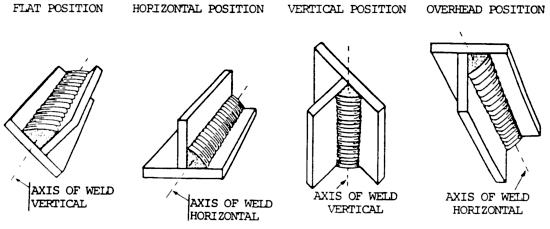Vertical position (3F and 3G) In the vertical welding position, the plate and the weld lie vertically or almost vertically. Force of gravity pushes the molten metal downward and having a tendency to it pile up. In another word, either upward or downhill vertical position can be implied. This requires left hand welding and right hand welding- ambidexterity is key to this position. 6G Pipe Test: Flickr. Now we we will go over the types of joints used in the main welding positions. Fillet Welds (F-Joints) F-joint (Fillet Weld) 1F, 2F, 3F, 4F, 5F (pipe) A fillet weld is when two pieces of material are welded together at a 90. You will use positions 3G and 3F for this weld position, which are a vertical groove and vertical fillet weld respectively. When you use these positions, gravity will try to force your molten metal downwards, which causes it to pile up in one spot of your point instead of getting evenly distributed along the entire weld. 3 shows the vertical welding position (including 3G and 3F positions) 4 shows the overhead welding position (including 4G and 4F positions) Q2: What is the difference between groove and fillet weld? The name of the groove welds comes from the characteristics of the weld. It is common to create a groove between welded sheets to make harmony.
- Welding Positions 1f
- 3f Welding Position
- Weld Position Chart
- 3f Welding Position Smaw
- Weld Test Positions
To see more information related to this topic go to http://www.sperkoengineering.com/html/asme.htm and click on the 'POSITIONS' link. Read the other articles too.
Positions used for testing welders and procedures are given designation by various codes. The commonly used codes in the US are Designations such as 1G,2G,3G,4G,5G,6G for groove welds. Fillet welds are designated as 1F,2F,3F,4F,5F.
These designations are for the position of the test only. I and I'm sure many others have either created or seen welder performance qualifications with that indicated a person was qualified for 1G,2G,3G,4G. That is incorrect. The positions qualified should be listed as Flat, Horiz, Vert, Overhead. The position the test was taken in refers to 1G, 2G etc.
This is referenced in ASME Sec IX's introduction. This refers to changes made in 1980.
The new revision to position indicates that a welder
qualifies in the 1G, 2G, 3G, etc., position and is then
qualified to weld, in production, in the F, V, H, or O
positions as appropriate. QW-461.9 is a revised table that
summarizes these new qualifications
Here is why

1) The test positions have limits on how far they can deviate from a given plane.
FROM ASME SEC IX
Groove welds may be made in test coupons oriented in
any of the positions in figure QW-461.3 or figure
Welding Positions 1f

QW-461.4 and as described in the following paragraphs,
except that an angular deviation of ±15 deg from the specified
horizontal and vertical planes, and an angular deviation
3f Welding Position
of ±5 deg from the specified inclined plane are permitted

during welding.
2) Welding positions have limits on how far they can deviate from a given plane.
Weld Position Chart
See ASME Sec IX
3f Welding Position Smaw
3) 1 and 2 above are NOT the same.
Weld Test Positions
A 3G test can tilt forward or backward 15 degrees and still be considered 3G. Tilt it forward or backward more than 15 degrees, it is no longer 3G nor is it a 1G or 4G. It is a special position. If I indicate I am qualified '3G' that does not include the position shown in the 2nd picture below. However if I indicate I am qualified Vertical, that includes the position shown in the picture below.
